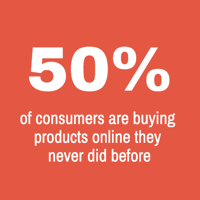The COVID-19 pandemic has led to dramatic shifts in consumer behavior. Safety and convenience have become more important than ever before as consumers have rapidly adopted new omnichannel and digital-first shopping habits. As retailers scramble to effectively serve customers through a variety of channels, the digital commerce experience has become a common denominator. But, what is digital commerce experience?
Gartner defines digital commerce experience as a highly interconnected process of searching, evaluating, and purchasing products and services across digital and physical sales channels with an agile path to purchase.
The experience thrives on the necessity to access product/service information throughout the buying journey, the flexibility to make the ultimate purchase and take delivery from a variety of online and offline commerce routes, and the ability to share/receive experience across customer networks.
Digital Commerce Experience in Retail: Trends
Largely accelerated by the COVID-19 pandemic, three key trends have emerged globally that retailers should stay on top of.
Surge in Ecommerce
The global coronavirus pandemic has driven 50% of consumers to buy products online they never did before. Meanwhile, 70% are buying more than usual.
The Experience Duality
While consumers reward great experience with price premiums and increased loyalty, 1 in 3 consumers would stop doing business with a brand they loved after one bad experience.
The Physical-Digital Interface Is a Priority
As consumers seek convenience and safety, services such as buy online pick-up in store (BOPIS), curbside pick-up, online delivery and one-day shipment become key drivers.



What Happens If You Don't Prioritize Digital Commerce Experience?
Retailers who don't prioritize digital commerce experience in today's world can suffer setbacks in three key areas.
Inability to serve up the right products, services, and experiences
Shopping experiences now often involve a combination of digital and physical channels. If a customer walked into your store, you wouldn’t ignore them, so why would you allow that for your digital channels? If you don’t know who a visitor is or what they are looking for, you’re not able to serve them the right products, services, or experiences they’re looking for. This leads to higher shopping cart abandonment, a loss of revenue, and worst of all, they’ll move their business to your competitors.
When customer feedback goes unaddressed, they simply walk away
Digital channels not only bring in revenue from net new purchases, but also help manage the continued relationship with customers post purchase. Often, retailers struggle with listening to, managing, and quickly closing the loop on customer feedback across customer journey stages. And, as we’ve already seen, one in three customers simply walk away after one bad experience.
Caught up in Reactive Mode
The market doesn’t stop, if anything it’s accelerating with economies reopening, new trends emerging, and new shopping habits being formed. New fulfillment methods such as curbside pick up, buy online pick up in store just scratch the surface. Retailers need to stay on top of evolving customer preferences and competitive offerings. Making informed decisions on where to invest and where to scale back is vital to retailers’ ability to survive and thrive.
How to Improve Your Digital Commerce Experience
What can you do to ensure your retail business isn't left holding the bag for lack of prioritization? By following advice in three areas, you can improve your digital commerce experience.
Know Your Digital Buyers
It all starts with developing an understanding of your digital buyers—who they are, who they are shopping for, their intended goals, and their preferences, motivation, and behaviors. What better way to learn about your customers and potential customers than connecting and engaging with them directly? Feedback asks that are in-the-moment, contextual, and easy for the consumer to respond to see greater engagement. You get bonus points if the feedback asks are also highly visual and branded so they tie in to your overall brand and experience promise. Website intercepts, in-app surveys and pop-up tools, when used smartly, help you paint the broad picture about your digital buyers.
Enhance Experience across Customer Journeys
With a plethora of brand choices and access to multiple channels, customer journeys are increasingly non-linear. To stay on top of how customers feel about interactions with the brand, retailers need to constantly seek feedback and do it at scale—across channels (digital and physical) and journey stages. The second and the more important aspect is acting upon the feedback collected. For instance, if a customer provides poor feedback after completing a new check-out process, how best can you triage that? As another example, think about a customer that gave one of your frontline staff a five-star rating for going above and beyond. Retailers need to manage hundreds and thousands of such feedback incidents every day—both positive and negative. Closing the loop on customer feedback makes customers feel valued and often encourages them to continue the relationship when negative feedback is quickly addressed. Customer feedback, when analyzed collectively, also uncover patterns and insights into what’s working well and what areas need improvement to enhance the overall experience.
Keep Pace with Evolving Market Conditions
There are customers that simply buy from you and there are customers that care about your brand. Retailers need the ability to not just identify such brand advocates but also engage them in an ongoing fashion for continuous learning and insights. Setting up digital insight communities or advisory boards can help retailers engage vested customers to stay on top of evolving customer preferences, shopping habits and motivation. Such customer groups can serve as sounding boards and help you make the right investment decisions so you are better prepared to proactively address changing market conditions.
Customer and Retailer Journey Intersections
In order to prioritize effectively and improve the digital commerce experience, it’s important to remember that while your brand has specific goals at each stage of the customer journey, consumers have their own goals. Successful retailers not only make a constant effort to improve their understanding of customer journeys, but also provide the right tools, support and experiences to help make the journeys seamless for customers.
Here's an illustration of customer and retailer journey intersections to give you an idea:
Driving Business Outcomes through Enhanced Digital Commerce Experiences
It doesn’t happen overnight. Enhancing the digital commerce experience is more of an ongoing journey than a destination. With the right people, processes, and technology along the way, retailers can:
-
Increase revenues by improving online conversions and proactively addressing customer churn
-
Improve the customer experience by seeking the truth based on customer feedback and putting that truth to action
-
Optimize the product mix by harnessing product level feedback
-
Improve brand equity by managing and positively influencing customer perceptions of the brand across interactions
Take the next step: Enhance the digital commerce experience. Read this ebook to get practical tips on how you can become more customer centric.









